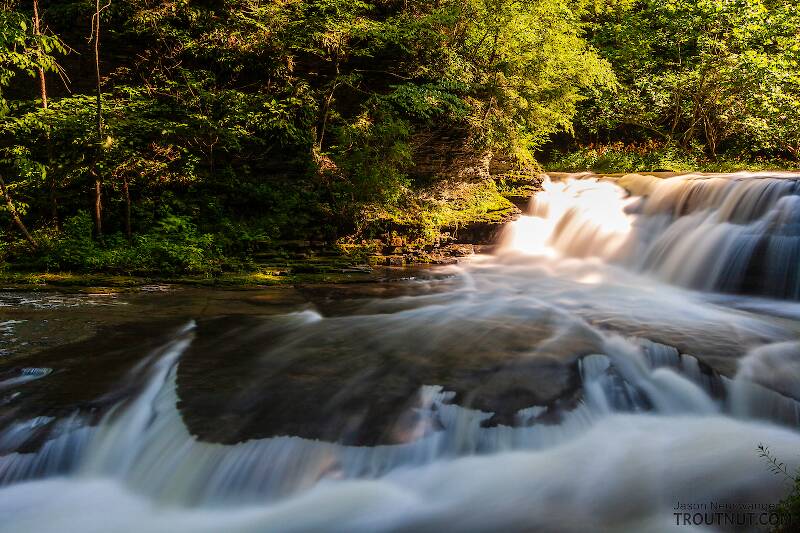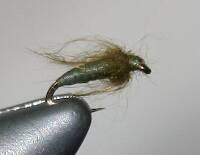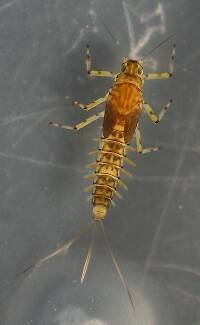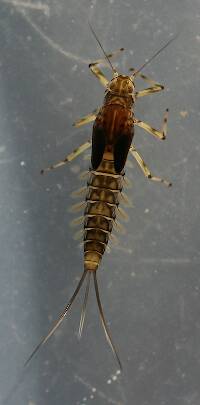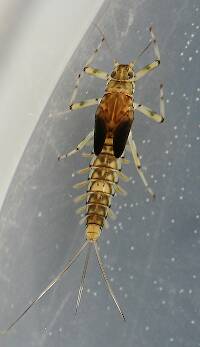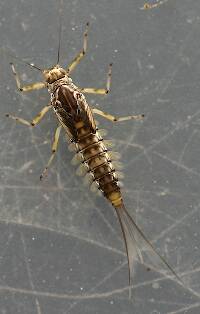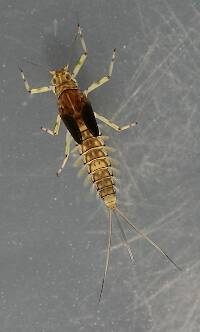
Hex Mayflies
Hexagenia limbata
The famous nocturnal Hex hatch of the Midwest (and a few other lucky locations) stirs to the surface mythically large brown trout that only touch streamers for the rest of the year.
Featured on the forum

This is a striking caddis larva with an interesting color pattern on the head. Here are some characteristics I was able to see under the microscope, but could not easily expose for a picture:
- The prosternal horn is present.
- The mandible is clearly toothed, not formed into a uniform scraper blade.
- The seems to be only 2 major setae on the ventral edge of the hind femur.
- Chloride epithelia seem to be absent from the dorsal side of any abdominal segments.
Based on these characteristics and the ones more easily visible from the pictures, this seems to be Grammotaulius. The key's description of the case is spot-on: "Case cylindrical, made of longitudinally arranged sedge or similar leaves," as is the description of the markings on the head, "Dorsum of head light brownish yellow with numerous discrete, small, dark spots." The spot pattern on the head is a very good match to figure 19.312 of Merritt R.W., Cummins, K.W., and Berg, M.B. (2019). The species ID is based on Grammotaulius betteni being the only species of this genus known in Washington state.
- The prosternal horn is present.
- The mandible is clearly toothed, not formed into a uniform scraper blade.
- The seems to be only 2 major setae on the ventral edge of the hind femur.
- Chloride epithelia seem to be absent from the dorsal side of any abdominal segments.
Based on these characteristics and the ones more easily visible from the pictures, this seems to be Grammotaulius. The key's description of the case is spot-on: "Case cylindrical, made of longitudinally arranged sedge or similar leaves," as is the description of the markings on the head, "Dorsum of head light brownish yellow with numerous discrete, small, dark spots." The spot pattern on the head is a very good match to figure 19.312 of Merritt R.W., Cummins, K.W., and Berg, M.B. (2019). The species ID is based on Grammotaulius betteni being the only species of this genus known in Washington state.

Troutnut is a project started in 2003 by salmonid ecologist Jason "Troutnut" Neuswanger to help anglers and
fly tyers unabashedly embrace the entomological side of the sport. Learn more about Troutnut or
support the project for an enhanced experience here.

This dun molted most of the way into a spinner (though the wings got stuck) the evening after I photographed it, so I took some more photos of the spinner.
I found a female nearby, probably of the same species.
I found a female nearby, probably of the same species.
Martinlf on Dec 23, 2006December 23rd, 2006, 12:21 pm EST
That sounds like some southern jive tune, doesn't it?
I seem to recall that we had a discussion about mayfly shucks a while back, in which we discussed the more opaque and dark coloration of invaria or rotunda shucks. These acerpenna shucks look much lighter, and greyish in color. Am I right? Are they also more translucent? What color are the nymphs, and what color Z=lon would you use to imitate a shuck on an emerger for this bug? Would this hold true for most baetids? This might explain the excellent luck I've had with the Little Lehigh olive emerger, (basically an RS2 design--see the Litle Lehigh Fly Shop website) which has a shuck of natural CDC that is fairly greyish in color.
Also, the first picture shows a clear difference in the color of the top and bottom of the abdomen, another good cue for dubbing color. Jason, these photos are amazing! I hope you have some luck with photos of emergers in the spring.
I seem to recall that we had a discussion about mayfly shucks a while back, in which we discussed the more opaque and dark coloration of invaria or rotunda shucks. These acerpenna shucks look much lighter, and greyish in color. Am I right? Are they also more translucent? What color are the nymphs, and what color Z=lon would you use to imitate a shuck on an emerger for this bug? Would this hold true for most baetids? This might explain the excellent luck I've had with the Little Lehigh olive emerger, (basically an RS2 design--see the Litle Lehigh Fly Shop website) which has a shuck of natural CDC that is fairly greyish in color.
Also, the first picture shows a clear difference in the color of the top and bottom of the abdomen, another good cue for dubbing color. Jason, these photos are amazing! I hope you have some luck with photos of emergers in the spring.
"He spread them a yard and a half. 'And every one that got away is this big.'"
--Fred Chappell
--Fred Chappell
GONZO on Dec 26, 2006December 26th, 2006, 12:28 pm EST
Louis,
The greyish shuck in the photos is the shed pellicle of the dun as the adult transforms into a spinner. The grey (dun) color reflects the duller coloration of the subimago and should not be taken as indicative of the nymphal shuck. I believe that most Acerpenna nymphs are brown to brownish-olive. Most mayfly shucks are more substantial and retain more color than caddisfly shucks. I assume this is because the exoskeleton has more of a protective/camouflage function for final stage mayfly nymphs than for caddisfly pupae (which transform into the pharate adult stage within a shelter). Of course, paler mayfly nymphs (like some burrowing nymphs) will have more translucent shucks (less pigment).
The greyish shuck in the photos is the shed pellicle of the dun as the adult transforms into a spinner. The grey (dun) color reflects the duller coloration of the subimago and should not be taken as indicative of the nymphal shuck. I believe that most Acerpenna nymphs are brown to brownish-olive. Most mayfly shucks are more substantial and retain more color than caddisfly shucks. I assume this is because the exoskeleton has more of a protective/camouflage function for final stage mayfly nymphs than for caddisfly pupae (which transform into the pharate adult stage within a shelter). Of course, paler mayfly nymphs (like some burrowing nymphs) will have more translucent shucks (less pigment).
Martinlf on Dec 27, 2006December 27th, 2006, 2:04 am EST
Duh. I don't know what I was thinking--or I was just not reading Jason's descriptions as I clicked around. Thanks again.
"He spread them a yard and a half. 'And every one that got away is this big.'"
--Fred Chappell
--Fred Chappell
Quick Reply
Related Discussions
Topic
Replies
Last Reply
2
Jul 2, 2009
by DayTripper
by DayTripper

